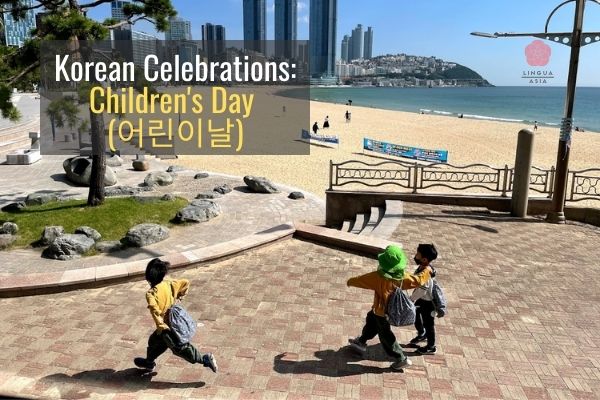Need another reason to give your kids gifts? You’re in luck, there’s a Korean Children’s Day!
You can enjoy it with your kids or even celebrate by yourself until you turn 28!
Children’s Day is like another Christmas in South Korea.

Key Takeaways
- Children’s Day is May 5th every year and a legal holiday in South Korea.
- The founder of Children’s Day is Bang Jeong-hwan.
- It’s to cherish children and boost their happiness.
When is Children’s Day in South Korea?
Children’s Day is May 5th every year and a full-blown legal holiday in South Korea.
It’s also a symbol of Family Month (가정의 달), which is in May and includes Parents’ Day (어버이날).
If the date falls on a Saturday, Sunday or Buddha’s Birthday, you still get a day off on Monday.
So, whether you have kids or not, Koreans like it since everyone gets a much-needed break from work.
What’s Children’s Day and why it’s important in Korea?
Technically, it’s to cherish children and boost their happiness. Also, to give them hopes and dreams.
Most Korean parents can’t spend that much time with their children due to busy work schedules. Korean children are also busy going to hagwon (학원). You might be surprised at how young Korean kids start studying (my friend’s kid is 5 and already studying TOEFL and 2nd grade math)
So, at least on Children’s Day, Korean families spend all day together, usually at the aquarium, zoo or amusement park like Lotte World or Everland.
※The whole population of South Korea plays the nunchi game on Children’s Day. They’re all worried about overcrowded amusement parks, so it sometimes ends up relatively empty. But the general rule is that you avoid these places on Children’s Day, unless you want to wait in line over two hours per ride.
The fertility rate in South Korea is now one of the lowest in the world, so children are becoming more important to society.
Insider Tips!
If you’re in Korea on May 5th, avoid kid-friendly areas like amusement parks, zoos, aquariums, movie theaters, etc. Well, pretty much everywhere fun. Also, restaurants like Pizza H*t or Outback S****house will be crowded.
What’s the origin of Children’s Day in Korea?
Back in the days like everywhere else, Korean adults considered children as labor or an extra mouth to feed, instead of respecting them as individuals.
Triggered by the March 1st Movement (3·1 운동) in 1919, youth groups were established to awaken the national spirit in children. In 1921, Cheondogyo Children’s Association (천도교소년회) was formed, and began to call children “Eorini (어린이)” to treat them as independent members of society.
In 1922, juvenile movement groups and newspapers gathered and came up with the idea to designate May 1st as Children’s Day, symbolizing children as new buds sprouting in spring.
On May 1st, 1923, Bang Jeong-hwan (방정환) and others announced Children’s Day and held the very first Children’s Day event in South Korea. The slogan of the event was “Let’s save hope, let’s save tomorrow”, emphasizing that children are the future of Korea.
Also, you can imagine how kids were treated in the past, as children’s activists shouted out slogans such as, “Do not curse, do not hit and do not work them (욕하지 말고, 때리지 말고. 부리지 말자)”.
Wohh, so glad I wasn’t born back then.
Who is Mr. Bang Jeong-hwan?
Bang Jeong-Hwan (방정환, 1899 – 1931), was an independence activist, children’s literature activist, children’s educator, social activist and founder of Children’s Day during the Japanese colonial period.
Every Korean knows who he is and we call him “방정환 선생님” as in Teacher or Mr. Bang Jeong-Hwan with respect.
He pretty much invented the word “Eorini (어린이)”, which was also the name of the children’s literature magazine he published.
Sadly, he died at the age of 31. (Why do the good ones go so young?!)
What ages are children in Korea?
Children at the Korean age of 13 or in 6th grade celebrate their last Children’s Day where they receive gifts. Once in middle school, they’re considered teenagers and no longer children (they’ll even have to go to hagwon on Children’s Day.) Then, they’ll have other things to think about like the upcoming suneung exam, and which skincare for teenagers is right for them.
However, you can still be a child (more of an 어른이 or kidult) and enjoy this holiday thanks to Mr. Bang Jeong-Hwan’s definition of a child’s age. He defined a “child (어린이)” as someone up to 1/3 of the average lifespan.
Back in the 1920s when the concept of children was first formed in Korea, the average life expectancy was 48 years, and according to the 1/3 rule, you were a child up until 16 years old.
But now, 1/3 of 83 years old is roughly 28. So……if you’re under 28, treat yourself with a nice gift!

What is the Children’s Day Song in Korea?
Yes, Koreans have songs for every occasion. This Children’s Day Song was composed in 1948.
The lyrics are:
| 날아라 새들아 푸른 하늘을 달려라 냇물아 푸른 벌판을 오월은 푸르구나 우리들은 자란다 오늘은 어린이날 우리들 세상 우리가 자라면 나라의 일꾼 손잡고 나가자 서로 정답게 오월은 푸르구나 우리들은 자란다 오늘은 어린이날 우리들 세상 | Fly, birds, up into the blue sky Run, stream, to the green field May is green, and we are growing Today is Children’s Day, when the world belongs to us Workers of the country when we grow up Let’s go forward hand in hand May is green, and we are growing Today is Children’s Day, when the world belongs to us |

Gift ideas for Children’s Day?
Most Korean parents take their children to fun places, nice restaurants, and buy gifts to celebrate this holiday.
Also, grandparents, samchon and emo buy gifts as a nice gesture.
Popular gift items are toys, dolls, video games, game consoles, kid’s clothes, children’s books, bicycles, etc.
More about Korean toys
When a kid’s birthday is on May 5th, they only get one combined birthday/Children’s Day gift. Those poor kids.
Check out our post about 17 Korean Gift Ideas for each Holiday and Occasion.
25 One-of-a-kind Korean Gifts You Can Buy Right Now
Subscribe for
exclusive info on Korea
Did we miss anything?
Let us know your thoughts or questions about Korean Children’s Day in the comments!



